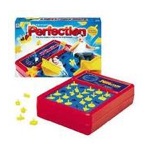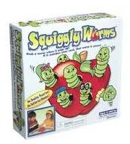Creative Use of Items You Already Own For Fluency Therapyc
 |
About the presenter: Patti Bohlman has been a speech and language pathologist for the Milwaukee Public Schools for 30 + years. Patti received her Bachelor of Science from Marquette University in 1978 in speech pathology and theology. She received her Master of Science degree at Marquette University in 1980 in speech pathology. She has a special interest in fluency and how other disorders (ADHD, PTSD, and Tourettes) affect therapy approaches for people who stutter. Patti has taught several classes on stuttering through McPherson College. She also has done presentations and in-services for school based speech pathologists. She lives in Milwaukee with her husband and her 18 year old dachshund-Maggi. |
Creative Use of Items you already Own for Fluency Therapy
by Patti Bohlman
from Wisconsin, USA
"I don't have any fluency materials! I have no money to buy them. "
If this is a familiar thought when you get a child that stutters, relax.
With a good framework of stuttering therapy and a plan for each child, these few little tidbits may help give you more activities.
Many times a game or therapy item I owned just "fell" into place for fluency therapy.
 One game called "Perfection" (Milton Bradley) is great for teaching about time pressure. Perfection is a game where a child tries to put all the pieces of various unusual shapes into the platform before the timer stops and the pieces pop up and off the game board. I use it to help children realize that it is easier to speak when they can slow down. The children love it. They also "feel" the tension in their body when the timer is on. I contrast it with playing the game with no timer on. I focus on the tension, but also the fact that they have time to formulate what they are going to do in the game. With the timer on, it is very hard to formulate your thoughts.
One game called "Perfection" (Milton Bradley) is great for teaching about time pressure. Perfection is a game where a child tries to put all the pieces of various unusual shapes into the platform before the timer stops and the pieces pop up and off the game board. I use it to help children realize that it is easier to speak when they can slow down. The children love it. They also "feel" the tension in their body when the timer is on. I contrast it with playing the game with no timer on. I focus on the tension, but also the fact that they have time to formulate what they are going to do in the game. With the timer on, it is very hard to formulate your thoughts.
 Another game that can help with this is "Squiggly Worms" (Pressman Toys). The object of the game is to take all your colored worms out of a large apple before the timer stops. Once again the parallel for therapy is to demonstrate time pressure and its effect on the body.
Another game that can help with this is "Squiggly Worms" (Pressman Toys). The object of the game is to take all your colored worms out of a large apple before the timer stops. Once again the parallel for therapy is to demonstrate time pressure and its effect on the body.
I have also used "Familiar Actions and Objects" to introduce a hierarchy of complex question forms. It has sets of cards with different levels of language complexity to play "Go Fish". It begins with a noun, and gradually adds adjectives and conjunctions. I also have made my own cards whenever I thought the complexity from the game materials was too great for the child. I am not sure if this product is still being sold. You can actually make your own "Go Fish" games with "Boardmaker" (Mayer-Johnson). For more complex sentence structures use the black and white images and color the images.
 Jack Prelutsky's "It's Halloween" book and tape (Scholastic-1996) allows the student to hear Jack use his voice in loud, soft, raspy, slow and fast manners of speech. They love both reading his poems and imitating his vocal patterns. A newer version of this book and CD (CD with other holidays) can be found on Amazon. A search of your books/CD's may reveal other such materials that will help CWS learn how to play with their voices. Children who stutter can learn to vary their voices, read with expression and develop good public speaking skills.
Jack Prelutsky's "It's Halloween" book and tape (Scholastic-1996) allows the student to hear Jack use his voice in loud, soft, raspy, slow and fast manners of speech. They love both reading his poems and imitating his vocal patterns. A newer version of this book and CD (CD with other holidays) can be found on Amazon. A search of your books/CD's may reveal other such materials that will help CWS learn how to play with their voices. Children who stutter can learn to vary their voices, read with expression and develop good public speaking skills.
With pragmatic skills and autism materials hitting the market, there are many social skill games and activities that can be adapted to fit the needs of a child who stutters. Often children who stutter need to be taught basic social skills. The focus is so much on not stuttering, many people forget (including slp's) to focus on these social skills. If the CWS also has ADHD, they may not have the ability to read social cues, effectively use turn taking skills and understand non-literal language.
I am hoping that the discussion will relate to materials that you have found to be useful in treating children who stutter.

